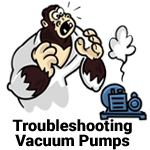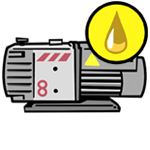
1- Location
Oil leaks may develop wherever two mating faces are sealed with a gasket. Such seams may fail as the result of deterioration of the gasket material, loosening of the screws caused by temperature variations, or improper care as the result of previous reassembly.
Typical gaskets seams in a mechanical pump are located at the oil level
window, the shaft seal, the oil drain, and the mating faces of such mechanical surfaces as the intake chamber cover, the oil case, and the exhaust chamber cover. The importance of a gasket seam is determined principally by its function.
If it is a vacuum seal, the ultimate performance of the pump is dependent upon it. If it is an oil seal, the pump may be operated satisfactorily for some time without loss of function. Eventually, of course, a great loss of oil may cause harmful damage.
Leaks from the pump's oil level window, shaft seal, or oil drain plug may be in-house repairable. Contact Us for the correct parts and repair advice.
Oil leaks from mating surfaces relating to the pumping module or oil case may require more technical skill to repair. Contact Us for the correct part, or have us service the pump for you.
2- Cause
- i) Always exhaust pump with the correct exhaust filter and replace filter element at signs of degrading, clogging or bubbling oil through housing. The wrong oil filter will restrict exhaust flow and create back pressure in pump.
- ii) If venting pump exhaust through hose, tubing or pipe, always be certain to use the same inner diameter of tubing as the exhaust port of pump. If the exhaust port is 3/4", use 3/4 inner diameter tubing for exhaust and so on. Restricting the exhaust of the pump will create back pressure and potentially a safety hazard.
3- Repairing Techniques
Be sure to uncover and remedy cause of seal degradation prior to repairing to avoid future failures.
An oil seam may be sealed by any of several methods. When an O-ring is employed, the surfaces of the O-ring and its groove should be wiped clean. If the O-ring is not badly deformed or scratched it may be reused by sealing with a slight film of vacuum oil or vacuum grease. Thin composition gaskets are generally used for large irregularly shaped areas. A replacement joint of this type should be thoroughly cleaned of all previous gasket material and the mating surfaces cleaned of any nicks.
Surface Preparation
Good Vacuum seals are an essential and important attribute of a good mechanical pump. A good seal is dependent upon the quality of the mating surfaces as well as the sealant and its preparation. The mating faces
should be carefully inspected for any projections or foreign particles which might interfere with proper mating.
Slight projections such as nicks and burrs are most easily removed by rubbing with a fine abrasive stone. The surface of the mating parts may be washed with a solvent or alcohol after which they must be thoroughly dried.
Temporary Repair
Temporary vacuum repairs are often made by covering the known leak with an industrial sealant such as Loctite with PTFE. Such a practice, however, is not recommended for seals of a permanent nature.
Contact Us for additional trouble shooting or repair assistance.


